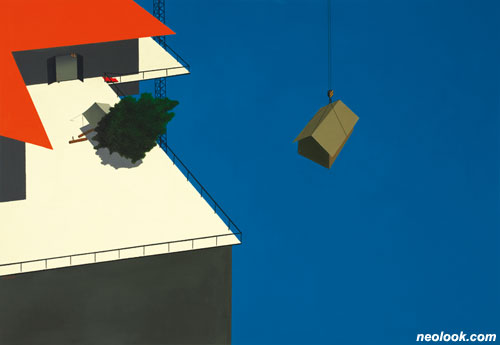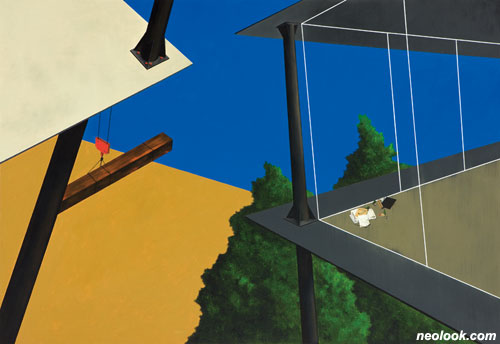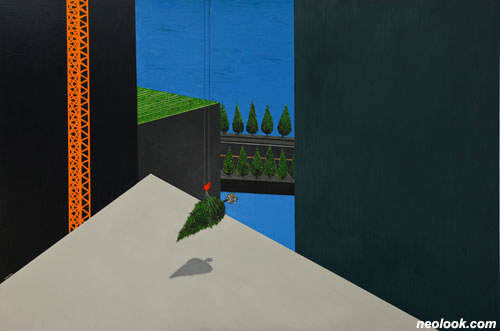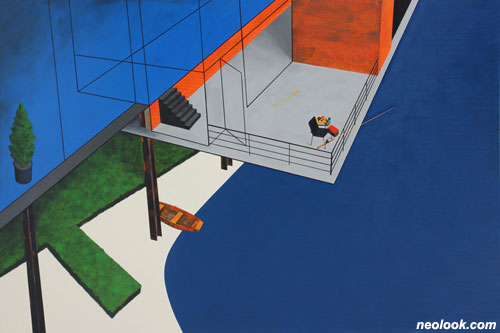- ● homepage
- ● archives
- ● restoration
- ● books
- ● big banners
- ● post board
- ■ neo's search
- ■ about us
- ■ 게재방법 안내
- 개인정보처리방침

- [email protected]
- Tel. 02_335_7922
- Fax. 02_335_7929
- 10:00am~04:30pm
- 월요일~금요일
- 3/3(월) 대체공휴일

Extra-Ordinary
민성식展 / MINSONGSIK / 閔聖植 / painting 2010_1111 ▶ 2010_1130 / 월요일 휴관
● 위 이미지를 클릭하면 네오룩 아카이브 Vol.20071117h | 민성식展으로 갑니다.
초대일시_2010_1111_목요일_05:00pm
관람시간 / 10:00am~06:00pm / 월요일 휴관
갤러리 현대 강남 GALLERY HYUNDAI GANGNAM SPACE 서울 강남구 신사동 640-6번지 아트타워 Tel. +82.2.519.0800 www.galleryhyundai.com
조화와 균형을 추구하는 상상의 공간 ● 미술이 종교와 세속의 절대세력에 봉사하던 시대가 지나면서 작가들은 자신들의 작품 속에 역사적, 사회적 문제보다 개인적 차원에서의 생각과 감정을 주입하는 방향으로 급격히 선회하였다. 이렇게 사적 사유 공간으로 전환된 화면 안에서 작가들은 이전에 경험해보지 못한 자유와 상상을 만끽할 수 있었으며 이러한 자유와 상상이 지배하는 장에서는 규범이나 원리와 같은 거추장스런 기준이 별로 잘 어울리지 않게 되었다. 서양미술사에서 일어났던 근대 유럽의 아카데미적 회화의 규범에 대한 저항은 결국 이러한 작가들의 상상력과 자유의 신장에 따른 자연스런 반작용으로 볼 수 있을 것이다. 민성식은 자신의 작품 속에서 자유롭게 상상하고 사유하며 신선한 조형 어법으로 우리에게 현대사회의 삶에 대한 메시지를 전달한다. 그는 보통의 작가들과 좀 다른 경로로 작가의 길을 걸어오고 있다. 미술대학 진학과 휴학, 미국으로의 이주를 통해 경험하게 되는 낯선 곳에서의 직업생활, 그리고 그로부터 이따금씩 찾아오는 그리움이라는 향수병, 다시 귀국해서 학업을 마치고 시작한 국내에서의 사회활동과 대학원 진학 등은 보통의 작가들의 이력과는 다른 다양한 경험과 소회를 자신의 작품 속에 풀어놓을 기회를 제공해주게 된다. 이러한 다양한 사회 경험으로부터 얻어낸 작가의 인생철학은 한마디로 '조화와 균형'이었다. 개인적 차원이든 사회적 차원이든 이러한 조화와 균형은 물질적인 면에서나 정신적인 면에서나 우리들에게 절실하게 요구되는 것이며 현대사회에서 이러한 균형이 상실됨으로써 우리의 정신 건강을 해치며 공허감이나 스트레스가 유발되고, 사회적으로는 집단간의 분쟁과 공격성이 증가한다. 또 이러한 조화와 균형은 도시와 자연 사이에서도 그 필요성이 절감되는데 특히 도시 생활에 얽매인 현대인들에게 자연은 치열한 도시생활에서 축적되는 스트레스와 독성을 치유하는 해독제와 같은 역할을 하고 있는 피난처이자 동경의 대상이 된다.

- 민성식_종이집_캔버스에 유채_112.1×162.2cm_2009
민성식의 작품은 이러한 조화와 균형을 염두에 두고 자연을 동경하는 도시생활 공간의 상징으로서의 집을 표현한다. 그의 작품에서는 도시인들이 꿈꾸는 공간으로서의 집이 그려지거나 타워크레인을 이용하여 높게 솟아오르는 고층건물의 공간을 표현하기도 하며, 오늘날 주거의 공간이 투자 혹은 투기의 대상으로 전락하는 현상을 목격하면서 집에 대한 생각을 하다가 착안한 종이로 만든 집처럼 단순하게 조립된 집모양의 도형들을 보여주기도 한다. 그리고 또 하나의 모티브로서 작가가 선택하고 있는 것은 어린 시절부터 스스로 의식하지 못한 상태에서 장난감 무기에 의해 길들여진 공격성에 대한 반성적 감회와 그 시절의 친구들에 대한 회상 등을 소재로 하여 화면 속에 이러한 것들을 풀어내고 있다.

- 민성식_공사중_캔버스에 유채_112.1×162.3cm_2010
민성식의 작품은 선명한 색감과 대담하게 구획된 분할된 화면의 전개, 그리고 이러한 장면을 내려다보는 부감법적인 구도로 특징을 이룬다고 할 수 있다. 그의 작품에는 마치 보안 카메라로 내려다보고 있는 듯한 감시하는 시선 혹은 훔쳐보는 시선이 느껴진다. 하지만 그의 작품 속에서 관람자가 위쪽으로부터 내려다보는 시선은 원근법적 원칙에서 벗어나 있어서 사실적인 느낌보다는 몽환적이고 신비스럽기까지 한 어떤 공간을 체험하게 해준다. 자세히 보면 민성식이 고안해낸 화면 속의 공간은 좀 이상스럽다. 작가 자신의 생활공간인 듯한 주택과 잔디가 깔린 마당이 바다나 강을 연상시키는 푸른색의 면과 인접해있기도 하고 크레인으로 옮겨지는 집모양의 입체에는 문이나 창이 하나도 없다. 그 뿐 아니라 주택의 내부에 배치된 가구와 생활 집기의 크기나 위치가 우리의 경험적 인식 속에서 요구하는 모습과 위치를 벗어나있는 경우가 대부분이다. 혹자는 이러한 민성식의 작품에서 형이상학적 회화를 구사하던 이탈리아의 형이상학파 화가 조르지오 데 키리코(Giorgio de Chirico)를 떠올리기도 한다. 데 키리코가 초현실주의에 선행하는 화가로도 여겨지는 것처럼 민성식의 작품에서도 우리는 초현실주의의 대표적인 표현기법으로서 벨기에의 화가 르네 마그리트가 즐겨 사용하였던 데페이즈망(depaysement) 기법도 발견할 수 있다. 예를 들어 주택의 차고로 생각되는 공간에 정박된 배나 타워크레인이 돌아가는 높은 건물의 끄트머리에 새처럼 앉아있는 작은 조각배, 지붕 처마 끝에 얹혀있는 물고기 한 마리, 허공에 떠있는 집과 테이블 위를 부유하는 육면체나 공 모양의 오브제들은 우리의 인식 속에서 정해놓은 사물의 위치와는 사뭇 다른 위치에 이들이 자리 잡음으로써 시각적 충격과 모호함을 자아내준다.

- 민성식_공사중_캔버스에 유채_97×145.5cm_2010
민성식의 작품은 멀리서 한 눈에 바라볼 때와 가까이 다가서서 세부를 자세히 바라 볼 때 서로 다른 느낌으로 감상할 수 있다. 전체적으로 그의 화면은 색면 추상과 같은 화면의 분할이 읽혀지며 이러한 색면 분할에 따른 색채의 균형과 대비를 위하여 경우에 따라서는 사실적인 색채와 비사실적인 색채를 화면 속에 함께 주입함으로써 보는 이로 하여금 한 화면 안에서 현실성과 환상적인 느낌을 동시에 느끼게 만들어 준다. 화면에 담긴 색채 감각에 비하여 민성식이 그려내는 사물과 건축 구조의 형태는 불안정하고 비현실적이다. 화면을 가로지르는 사선들은 원근법적 소실점과 일치하지 않음으로써 건물이나 주택의 실내 공간을 비뚤어지고 불안정하게 만들고 있으며 각 부분의 스케일 면에서도 비례나 균형이 정확하게 맞지 않음으로써 관람객들이 이 공간이 현실의 공간이 아니라 가상의 공간, 비현실과 환상을 경험하게 만들어주는 공간으로 인식하게 해준다. 2008년에 제작한 「개집」의 경우에는 화면 앞부분에 부분적으로 붉은 색 벽과 지붕의 일부가 보이는 집의 구조가 마당에 놓인 개집의 구조에서 그 기울기나 지붕의 각도 면에서 다시 한 번 반복됨으로써 두 개의 집이 결국 동일한 구조를 가진 공간일 수 있다는 상징적인 의미를 지닌다. 즉 동물들이 자신들의 집을 재산으로 인식하지 않는데 비하여 인간이 자신들이 살고 있는 집을 재산 증식과 투자 혹은 투기의 대상으로 생각하는 것에 대한 풍자적 시각이 이 그림에 반영되어 있을 수도 있다. 그런데 이러한 진지한 주제를 희석시키는 것은 작가가 화면에 도입하는 색채라고 할 수 있다. 붉은 벽과 인접한 녹색 잔디밭의 대비, 그리고 전면을 가로지르는 비스듬한 십자 형태의 굵고 검은 색 창틀을 통해 이러한 광경을 내다보는 듯한 시선, 이러한 요소들이 민성식의 작품의 특징을 이룬다고 할 수 있다.

- 민성식_수영장_캔버스에 유채_112.1×193.9cm_2009
민성식의 화면을 사실적인 묘사와 함께 색면 분할 형식의 추상으로 읽을 수 있는 것처럼 주제 면에서도 현실과 환상의 공존, 도시와 자연의 공존 등으로 읽을 수 있을 것이다. 민성식은 오래 전부터 극단적인 원근을 적용하여 모서리를 드러내는 건물의 모습에 매력을 느꼈다고 말하기도 하였다. 타워크레인이 건축 자재를 옮기면서 높은 건물을 세워 나아가는 화면 속에서 우리는 도시공간의 기능주의적이고 비인간적 건조함을 느끼면서 이러한 환경에 대응하는 균형추로서 자연을 희구하게 된다. 황량하다는 느낌마저 드는 고층 건물의 한 귀퉁이에서 낚싯대를 어깨에 메고 걷는 인물은 건물의 규모에 압도되어 더욱 왜소해 보이지만 마치 거센 바람 앞에서도 꺼지지 않는 불꽃처럼 도시에서 생활하는 현대인의 꺼지지 않은 꿈과 희망에 대한 은유로 읽힐 수도 있다.

- 민성식_목수의 집_캔버스에 유채_80.3×116.8cm_2009
민성식이 관심을 두는 또 하나의 모티브는 어린 시절의 장난감에서 영감을 얻은 목총이다. 위치를 가늠하기 어렵게 설정된 허공을 배경으로 둥둥 떠 있는 듯한 커다란 나무총은 어린 시절의 민성식과 같은 또래의 아이들이 전쟁놀이를 할 때 즐겨 사용했던 장난감이었을 것이다. 「훈련무기」라고 이름을 붙인 일련의 작품에서 작가는 어린 시절부터 스스로 의식하지 못한 상태에서 장난감 무기에 의해 길들여진 공격성에 대한 반성적 감회와 그 시절의 친구들에 대한 추억을 떠올리고 있었을 것이다. 하지만 이러한 회고적 감성을 넘어서서 민성식의 「훈련무기」 연작에서는 작가가 앞서 즐겨 그려왔던 건축물들의 장면들과 공유되는 선들의 교차가 감지된다. 다만 이러한 그림에서는 보다 정교하게 선들의 교차와 평행이 이루어지고 그 교차로 형성된 면에 채색이 가해짐으로써 보다 추상적인 화면을 구성하게 된다. 건축에 대해 남다른 관심을 가진 민성석이 작품을 통해서 구성해내는 공간은 작가 본인의 경험과 희망을 담아내는 공간이다. 이러한 공간에서 벌어지는 일상과 상상 속의 일들은 우리가 익숙하게 인식하고 있는 공간에 대한 감각과 조형 어법을 벗어남으로써 더욱 신선하다. 낯선 듯하지만 결국 그것은 오늘날 도시와 자연 사이에서 현실과 이상을 오가는 우리의 의식 속의 공간이며 그 속에서 생활하고 꿈꾸고 희망하는 우리의 모습일 수 있는 것이다. ■ 하계훈

- 민성식_낚시가기-집에서_캔버스에 유채_130.3×193.9cm_2010
Imaginary Space Aspiring to Harmony and Balance ● As Art has moved away from the confines of being a subordinate to religious and secular power, we have started to see drastic changes in the field. Artists have taken the liberty of infusing their personal thoughts and emotions into their works, rather than being buffeted merely by historical and/or social context. Through this phenomenon, artistic works are now transformed as a kind of platform that unfolds personal perception. Artists now enjoy an unprecedented freedom of imagination and, on such a platform where freedom and imaginary impetus are dominant, any overpowering norms or principles are regarded as unnecessary or even burdensome. Perhaps the anti-academic movement observed in the early modern era in Europe could be viewed as a natural counter-reaction with regards to such augmentation in artistic freedom and imagination. ● Min Song-Sik delivers his unique message, commenting on our contemporary society with liberated imagination and new formative lexicons. Min has followed somewhat different paths than his contemporaries. After starting his formal education, he then took a leave of absence to the USA, working there. He had to adjust into a whole new and different environment. Those were days of homesickness and nostalgic ambience. Min then returned to Korea, completed a bachelor's and master's degree, and embarked on a social career. Such a varied background provided him with valuable opportunities to explore and breathe through various experiences and reflections on his life. ● Min's life principle learned from those times was 'harmony and balance'. At both a personal and social level, harmony and balance are one of the fundamentals to our spiritual or materialistic well-being. We frequently encounter how the loss of such balance and harmony causes harm to mental health, causing emptiness and stress. These side effects also cause an increase in disputes and aggressiveness in social and individual groups. In this regard, the notion of harmony and balance are especially important in balancing the relationship between the urban cities and the rural area or nature, while nature is a place or cause to which we can resort to detoxify, escaping from stress accumulated from the intense competition of city life. ● Min's works depict the house as a symbol of urbanity-life-place in which we still aspire to be close to nature, a place of genuine harmony and balance. In his works, the house is a metaphor of the ideal place that all urban residents dream of. Sometimes, the house is placed on a crane to symbolize high-rise skyscrapers. Some houses look like houses of cards, implying that the house has been downgraded as some means to end in investment or speculation; at times, they look like miniature doll houses, roughly assembled. Another motif is his reflective recollections and his nostalgic reminiscence of his childhood times and childhood friends, which at the same time includes a kind of aggressiveness of that time, as if being tamed by a toy weapon at the unconscious level. ● Min's works are characteristic of vivid color, bold composition and a bird's-eye view perspective. His works remind us of a surveillance camera, similar to the gaze of a peeping tom. However, his gaze does not strictly correspond to the perspective representation, leaving his works imbued with a somewhat dreamy or even mysterious hue, reminding us of the unknown. ● On closer look, we notice that there's something strange in the given spaces. The residential house neighbours a blue surface that reminds one of a lawn garden, an ocean or a river. A house-like, three dimensional structures that is being moved by crane lacks, doors or windows. The composition of the interior furniture or the sizes of the domestic materials do not meet the usual human expectations that we maintain in our experiential platform of perception. ● Min's works may remind some viewers of Giorgio de Chirico, an Italian metaphysical artist, regarded as a pre-surrealist artist. Similarly, from Min's works, we can also see hints of the depaysement technique openly adopted by Rene Magritte to complete his surrealist works. For example, we can spot a little boat tumbled on the top edge of a high building or turning tower crane; a ship parked in a residential garage; a fish placed at the end-edge of roof eaves; a house floating in the air, a hexahedron or sphere-like object up in the air above a floating house or table. These images resonate with visual shock and ambiguity because they are placed outside of the expectations within our perception. ● Min's works can be viewed from two different stances: on a closer look and from a distance. Overall, his canvas shares similarities in color field abstract paintings, and he meticulously combines colors both realistically and non-realistically, through which he achieves a balance and contrast of colors and color fields. This in turn generates an integration of realistic and illusionary ambience. Compared to the realistic colors of the canvas, the shape and structural composition of objects are dubious and unrealistic. For example, the diagonal lines that mark the canvas do not correspond to the actual perspective vanishing point, distorting the interior space or the external shape of buildings or structures. The scale of the peripheral-whole ratio is also slightly mismatched, so that the viewer recognizes this space as some virtual reality space or a space that stimulates the estranged feelings that one experiences with unreal illusions. ● From the 「Dog House 」 created in 2008, we can see the partially-colored red wall and house structure that integrates wall and roof, this composition again resonates in the structure of the dog house, with a slightly-slanted roof. This in turn creates the idea that these two seemingly-separate houses are in fact, the same place with similar structure. What this painting connotes is that the animal, a dog in this case, does not regard his house as an asset while humans view their house only as an investment tool or object for monetary speculation. We can glimpse Min's somewhat satirical stance in this work but such a seemingly-grave subject is diluted due to the vivid colors that Min uses. The contrast of the red wall and green lawn, and the downward gaze through dark, thick colors, cross-shaped, slightly-slanted window frames are typical characteristics of Min's works. ● With his realistic portrayal and color field abstraction, we can also read the concurrence of the reality and illusion of the cohabitant of urban life and nature. Min repeatedly stated that he is intrigued by edge-revealing buildings. In some of his works, we can see a derrick crane building a high-rise structure whilst also transporting the building material to and from; with this, we can espy the functional-oriented, inhumane aridness of the urban space. We turn to nature as a counterweight that can compensate such an antagonizing environment. From the corner of a bleak high-rise, we can find a small man walking on the corner of the building with a fishing rod on his shoulder. The surroundings must be daunting to him, and he seems to be engulfed by them; but, we can sense that his spirit is gigantic, as of a candle resisting a blowing wind. This could be a metaphor of the dream and aspiration of the urban man who overcomes the ordeals of urban life. ● Another motif that interests Min is the toy wooden gun with which he used to play when he was a small boy. On his canvas, these enlarged toy guns float in the air, unable to trace the actual location or spatial relation. These toy guns must have been one of his favourite childhood toys. The title of these series of works is 「Training Weapon 」, and from this we can sense that he might wish to highlight a reflective and nostalgic recollection of his childhood and childhood friends. However, Min's adherence to his previous theme of building works can still be found in the intersecting lines and spaces. He achieves a more articulate intersection and parallel of lines while colors are added to the spaces produced by the intersecting lines. This in turn results a more abstract canvas. ● Min has a special interest in architecture, and he creates a very unique space in his works that resonates with the artist's personal experiences and inspirations. The routine and the imaginary in his world echo with an even more unique message because they betray our usual expectations of the familiar spaces in our perception. They seem unfamiliar, but these spaces are still the spaces within our consciousness, and we can see our own existences that live, dream and aspire within such spaces. ■ Ha Kye-hoon
Vol.20101111b | 민성식展 / MINSONGSIK / 閔聖植 / painting

